|

by
Jeffrey Mishlove, PhD
December 2001
from
TWM
Website
recovered through
WayBackMachine Website
German version
Space-Time According to Einstein
The special theory of relativity, formulated by Albert Einstein in
1905, is based on the experimentally confirmed idea that the
velocity of light is the same universal constant, c= 3x1010
cm./sec., for all observers who move uniformly in straight lines
relative to each other.
Consequently, Einstein’s genius deduced that
events which are simultaneous to one observer are not simultaneous
to a second observer.
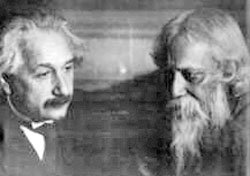
Nobel laureates
Albert Einstein, scientist,
and Rabindranath
Tagore, mystical poet
Furthermore, moving clocks run slow.
Moving measuring sticks contract in length along the direction of
motion.
Energy is equivalent to mass - i.e. E = mc2. And
the mass of a particle increases to infinity as the velocity
approaches that of light. Einstein’s results have been confirmed
many times in physics laboratories.
Like all scientific facts, these results presuppose that the
observers are in a common state of consciousness whose legitimacy is
determined by their agreement or social contract. The legitimacy
accorded any scientific theory is a sociological matter. In fact,
one interpretation of quantum physics is that physical reality does
not objectively exist independent of the participating observers.
Physicists use a simple geometric picture of the flat spacetime of
special relativity called a "Minkowski diagram." Relativity unites
space and time into a unified "four dimensional space-time
continuum" in which time appears in the distance formula with a sign
different from the sign of space. Events are conceived of as points
on the Minkowski diagram.
The history of a sequence of events is
described by a curve or path on the Minkowski diagram called a
world
line.
Each event is the origin of a future light cone and a past
light cone.
-
World lines that are everywhere inside the light cones
are called time-like and describe the history of particles moving at
velocities less than the velocity of light.
-
World lines that are
everywhere on the light cones are called light-like and describe the
histories of real photons, neutrinos and gravitons that move at
exactly the velocity of light.
-
World lines that are everywhere
outside the light cones are called space-like and would correspond
to tachyonic processes happening faster than the velocity of light.


Space-like processes, if they exist,
could be in two or more widely separated places at the same time.
Furthermore, these space-like processes allow the effect to precede
the cause for some observers and not for others. They are not
allowed in classical physics but are acceptable in quantum physics
according to some interpretations.
Quantum transitions or "quantum
jumps" may be thought of as space-like processes.
Folded
Space
Some psi researchers have attempted to use the concept of curved spacetime to eliminate some of the apparent paradoxes involved in
psi phenomena.
Psychologist Gertrude Schmeidler has suggested that
the universe may contain an extra dimension that permits
"topological folding" to occur so that two regions which are widely
separated in an Einsteinian universe might be in immediate contact,
much as two points on a towel which are normally quite a distance
apart may be adjacent when the towel is folded.
Thus, apparent
instances of ESP across great distances might be explained by
postulating that the persons involved are somehow in close proximity
in the "folded" space.
Physicist John Archibald Wheeler (a man with pronounced
antipathy toward psi research) has theorized that, at a microscopic
level, quantum effects might tear the fabric of spacetime, producing
a structure involving wormholes. He speculated that such wormholes
could connect pairs of oppositely charged particles such as
electrons and positrons. Wheeler’s hypothetical structure is
sometimes called the "quantum foam."
Such wormholes may exist on a
macroscopic scale and, in some cases, rotating black holes may give
rise to a "tunnel" or shortcut to another region of spacetime.
|
A
contemporary physicist, John Wheeler, has
expressed this new approach in particularly graphic
terms:
"We
had this old idea, that there was a universe out
there, and here is man, the observer, safely
protected from the universe by a six-inch slab of
plate glass. Now we learn from the quantum world
that even to observe so minuscule an object as an
electron we have to shatter the plate glass; we have
to reach in there... So the old word observer-simply
has to be crossed off the books, and we must put in
the new word participator. In this way we’ve come to
realize that the universe is a participatory
universe.
|
Physicist Fred Alan Wolf has
implicitly suggested (in a cartooned text called Space, Time and
Beyond) that such wormholes may provide the connections needed to
explain psi phenomena over long distances or temporal intervals.
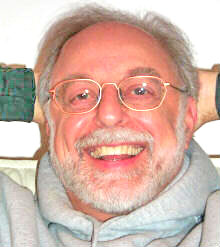
Fred Alan Wolf
Wolf, himself, has become one of the
most prolific and articulate writers interpreting the complexities
of theoretical physics to a general audience - particularly those
interested in psi and consciousness.
His book,
Parallel Universes,
is probably the best popular explanation of Everett and Wheeler’s
"many worlds" interpretation of quantum mechanics.
Multidimensional Spacetime
Multi-dimensional models of spacetime have been proposed by
physicist/psi researchers
Russell Targ,
Harold Puthoff and
Edwin
May.
They proposed that ordinary four-dimensional Minkowski
spacetime may be the "real" part of an eight-dimensional complex
spacetime.
An eight-dimensional models of spacetime to account for psi have
also been proposed by physicist Elizabeth Rauscher. She suggests
that soliton waves in a complex multidimensional space might serve
as possible psi signals, as they would be able to propagate over
large "distances" with little attenuation. She asserts that signals
that appear to be superluminal in four-dimensional spacetime may be
subluminal in eight-dimensional spacetime.
She also contends that
the problem of causal loops arising from backward causal chains need
not arise in eight-dimensional spacetime.
Rauscher suggests that any space-time
dependence that exists for psi effects may be accounted for in terms
of signal propagation velocities in complex spacetime. However, it
is not clear that Rauscher’s theory can be tested by this method
unless some means of measuring the complex coordinates are provided;
otherwise, they simply constitute free parameters that may be
adjusted at will, rendering the theory incapable of falsification.
A more comprehensive and sophisticated hyperspace model, developed
by Saul-Paul Sirag, is summarized in this section under the heading
of "unified field theories" and developed further in the Appendix.
The EPR
Effect and Bell’s Theorem
Recent theoretical developments in quantum theory known as the EPR
effect (named Einstein, Podolsky and Rosen’s 1935 paper on the
quantum connection between spatially separated systems), now
formulated in a theorem by John S. Bell (called
Bell’s Theorem), allow for the an
instantaneous effect between any two places in the physical
universe.
There is no violation of Einstein’s theory of relativity
because the effect does not require the propagation of energetic
signals.
The confirmation of this principle of nonlocality suggests
that psi phenomena, if they exist, need not be in conflict with the
established laws of science.
The prejudice of classical causality says that an event can only be
influenced by other events that are in its past light cone. Events
in the future light cone and outside the light cone in the "absolute
elsewhere" are said not to influence the event of interest.
Classical causality does work on the statistical level in which we
average our observations over sets of events. Almost all of the
measurements of atomic physics are adequately described by the
statistical limit of the quantum principle.
However, both general relativity and quantum theory in the form of
Bell’s theorem show that classical causality is not correct in
principle on the level of individual events. Recent experiments by
John Clauser at U.C., Berkeley, and
Alain Aspect at the University of Paris,
show that classical causality is violated for individual atomic
events. (Local causes operate within the velocity of light.)
These
experiments measure the simultaneous arrival of two photons at
spatially separated detectors. The two photons originate from the
same atom. Bell’s theorem enables one to calculate what the r`0d of
simultaneous arrival should be if the statistical predictions of
quantum theory are correct. It also enables one to calculate the
rate of simultaneous arrival if physical reality is objective and
locally causal for the individual photons.
The experiments of Clauser and Aspect contradict the rate of photon
coincidences predicted on the basis of an objective and locally
causal reality. The measured rate agrees with the prediction of
ordinary quantum theory. This means that physical reality either is
not subject to the principle of local causation or does not
objectively exist independent of the observers who participate in
its creation.
Bell’s Theorem and the related experiments may have importance for
the understanding of personal human experience. The human brain
stores and processes its information at the level of single organic
molecules and is a single macroscopic quantum system. Acts of
consciousness may be viewed as incorporating quantum events.
The illusion of the classical scientific paradigm that is shattered
by the quantum principle is the assumption that there is an
immutable objective reality "out there" that is totally independent
of what happens in consciousness "in here." Quantum theory forces a
new kind of logic in science that is still mathematical and
disciplined.
The Nobel prize physicist Eugene Wigner of Princeton
has repeatedly written that consciousness is at the root of the
quantum measurement problem.
|
This is
called the "quantum measurement paradox." It is a
paradox because who are we to do this conversion?
Because after all, in the materialist paradigm we don’t
have any causal efficacy. We are nothing but the brain,
which is made up of atoms and elementary particles. So
how can a brain which is made up of atoms and elementary
particles convert a possibility wave that it itself is?
It itself is made up of the possibility waves of atoms
and elementary particles, so it cannot convert its own
possibility wave into actuality. This is called a
paradox. Now in the new view, consciousness is the
ground of being. So who converts possibility into
actuality? Consciousness does, because
consciousness does not obey quantum physics.
Consciousness is not made of material. Consciousness
is transcendent.
Do you see the paradigm-changing
view right here—how consciousness can be said to create
the material world? The material world of quantum
physics is just possibility. It is consciousness,
through the conversion of possibility into actuality,
that creates what we see manifest. In other words,
consciousness creates the manifest world. |
All classical measurements, including classical measurements of
quantum processes of the type considered by Heisenberg in his
"microscope" that leads to the uncertainty principle, involve the
actual flow of energy and momentum in order to convey information.
For example, Heisenberg reasons that the position of an electron
must be measured by means of a second particle, e.g. a photon, that
must collide with the electron in order to get the information on
the electron’s position. The fact that action is quantized in units
of Planck’s constant, h 10-27 erg-sec., implies uncontrollable
minimal energy and momentum transfers between photon and electron in
the collision.
The result of Heisenberg’s thought
experiment is that it is impossible to predict the simultaneous
values of both the position and the momentum of the electron with
complete certainty. The only way to gain knowledge of the
uncertainties is to repeat the experiment many times under
"identically prepared" conditions. These kinds of classical
measurements of quantum processes are fundamentally statistical.
Josephson proposes that there may be another level of
measurement that transcends the limitations of Heisenberg’s
uncertainty principle.
He says that this limitation is perhaps only
a,
"reflection of the kinds of observation we can make," and that
"the physical description of the world would change radically if we
could observe more things."
Einstein was also firmly convinced that
there was another way to knowledge, but his refusal to accept the
"telepathic" implications that he saw so clearly in his
EPR effect
prevented him, like Moses, from seeing the promised land.
Thus,
Einstein’s Autobiographical Notes contain this remark about
the EPR
effect:
There is to be a system which at the
time t of our observation consists of two partial systems S1,
and S2, which at this time are spatially separated.... If I make
a complete measurement of S1, I get from the results...an
entirely definite Y-function Y2 of the system S2.
The character
of Y2 then depends upon what kind of measurement I undertake on
S1.... One can escape from this conclusion only by either
assuming that the measurement of S1 (telepathically) changes the
real situation of S2 or by denying independent real situations
as such to things which are spatially separated from each other.
Both alternatives appear to me entirely unacceptable.
It is very interesting to note here that
the Y function referred to by Einstein is the standard quantum
probability function, referring to the mathematical probabilities
which underlay the subatomic interactions of the physical world
(i.e., Schrodinger’s Wave Function).
At least one physicist has
commented on the possible synchronicity that this physical term may
be very relevant in the psi effect of consciousness researchers.
Physicists have actually developed a number of possible conceptual
strategies for integrating the EPR effect and Bell’s Theorem.
Physicist Nick Herbert, in his book Quantum Reality,
describes eight possible interpretations:
-
there is no underlying
reality
-
reality is created by observation
-
reality is an undivided
wholeness
-
there are actually many-worlds
-
the world obeys a
non-human kind of reasoning
-
the world is made of ordinary objects
-
consciousness creates reality
-
unmeasured quantum reality exists
only in potential
Each of these interpretations poses its own
paradoxes. Given Bell’s Theorem and the EPR effect, all of them must
allow for non-local (or superluminal) interactions.
|
Nick
Herbert holds a Ph.D. in experimental physics from
Stanford University. He was senior scientist at Memorex,
Santa Clara, and other Bay Area hardware companies
specializing in magnetic, electrostatic, optical, and
thermal methods of information processing and storage.
He has taught science at all levels from graduate school
to kindergarten including the development, with his wife
Betsy, of a hands-on home-schooling science curriculum.
Nick was
the coordinator (along with Saul-Paul Sirag) of
Esalen Institute’s physics and consciousness
program and has led many workshops on the quantum
mechanics of everyday life. He is the author of
Quantum Reality: Beyond the New
Physics,
Faster Than Light
(published in Japan under the title Time Machine
Construction Manual),
Elemental Mind: Human
Consciousness and the New Physics, and he
devised the shortest proof of Bell’s interconnectedness
theorem to date. |
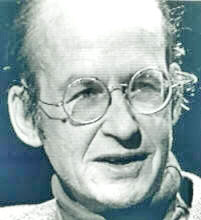
Nick Herbert
The Implicate
Order
The nonlocal nature of the state vector collapse, as described
above, suggests that particles of matter are not accurately
describable as separate, localized entities.
Rather seemingly
isolated or separate particles may be intimately connected with one
another and must be seen as parts of a higher unity.
Physicist
David Bohm has referred to the
universe as a "holomovement," invoking an analogy to a hologram (a
three-dimensional photograph in which the entire picture is
contained in each part). Bohm has termed the world of
manifest appearances the "explicate order" and the hidden (nonlocal)
reality underlying it the "implicate order." He also proposes a new
mode of speaking, which he calls the rheomode, in which "thing"
expressions would be replaced by "event" expressions.
In contrast with theories such as Evan Harris Walker’s and Saul-Paul Sirag’s, the implicate order theory lacks a specific mathematical
formulation from which testable predictions may be derived.
On the
other hand, the implicate order theory is consistent with and
provides a good philosophical underpinning for the testable
observational theories, such as those of Mattuck and Walker.
Observational Theories
Physicist Evan Harris Walker has put forth an observational theory
that equates the conscious mind with the "hidden variables" of
quantum theory.
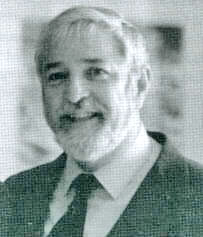
Evan Harris Walker
Walker notes that, due to the
necessarily nonlocal nature of such hidden variables, quantum state
collapse by the observer should be independent of space and time;
hence, psi phenomena such as telepathy should be independent of
space-time separation.
Noting that the conventional view in physics is to deny that the
paradoxes of quantum mechanics have implications beyond the
mathematical formalisms, Walker defines his theory:
The measurement problem in Quantum
Mechanics has existed virtually from the inception of quantum
theory. It has engendered a thousand scientific papers in
fruitless efforts to resolve the problem. One of the central
features of the controversy has been the argument that
characteristics of QM imply that an observer’s thoughts can
affect an objective apparatus directly, which in turn implies
the reality not only of consciousness but of psi phenomena.
I
have written several papers saying that such a feature of QM is
not a fault, but rather represents a solution to problems that
go beyond the usual perview of physics. Thus, I have developed a
theory of consciousness and psi phenomena that arises directly
from these bizarre findings in QM, findings now supported by
specific tests of the principles of objective reality and/or
Einstein locality.
Walker specifies channel capacities for
various "regions" of mental activity.
He calculates the rate for "dataprocessing
of the brain as a whole at a subconscious level" (S) to be euqal to
2.4 x 1012 bits/sec. The data rate for conscious activity (C) is
equal to 7.5 x 108 bits/sec, and the channel capacity of the "will"
(W) is equal to 6 x 104 bits/sec.
Walker’s derivation of the above rates is based on the assumption
that electron tunneling across synapses is the basis for the
transmission of impulses across synapses and that the large-scale
integration of brain activity is also mediated by electron
tunneling.
Copenhagen physicist Richard Mattuck has proposed an observational
theory which builds on the work of both Helmut Schmidt and Evan
Harris Walker.
He asserts that PK results from the restructuring of
thermal noise through the action of mind, involving a decrease in
entropy. His hypothesis is "not of the ’Maxwell demon’ type" as "it
does not operate by selection of states of individual molecules, but
rather by the selection of macroscopic pure states." Using the
example of a moving ball, Mattuck notes that, as its velocity is
distributed about its current mean due to thermal noise, an observer
can select increasingly higher velocity states.
This selection may
be made in steps, resulting in possible incremental increase in
velocity by the ball.
Unified
Field Theory and Consciousness
A hyperspace model of consciousness has been developed by
interdisciplinary scholar Saul-Paul Sirag, at the Institute for the
Study of Consciousness in Berkeley and San Francisco’s
Parapsychology Research Group.
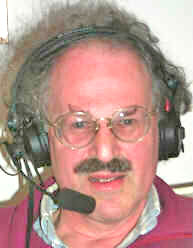
Saul-Paul Sirag
Further details of Sirag’s
work-in-progress are presented in the Appendix.
In my estimation,
this work (while incomplete) represents the most advanced model
available linking consciousness at a deep level with physical
reality. I have been closely associated with Sirag since before he
began this work in 1974, when he was a research associate at the
Institute for the Study of Consciousness (ISC) in Berkeley. Frankly,
after years of detailed discussions with him, I still find it very
difficult to comprehend his model.
I have included it as an Appendix
to the revised edition because I believe that Sirag may well be
speaking the language of the future in consciousness research.
Here
is the story of the development of Sirag’s approach:
Arthur Young, the founder of the Institute (whose own "reflexive
universe" model is presented next this this section), asked Sirag to
work out the algebraic group structure of the rotations of the
tetrahedron.
Young also encouraged Sirag to study the works of Sir
Arthur Eddington, the physicist who was famous for producing a
nearly incomprehensible unified field theory, which purportedly
unified gravity and electromagnetism as well as general relativity
and quantum mechanics.
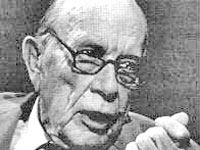
Arthur M. Young
The key to this unification was also
group theory.
Sirag was impressed by the fact that, although
Eddington’s work had been neglected for decades, the central
importance of group theory for unified field theory had become
established by recent physics.
Eddington’s unification was based upon the 4-element group called the Klein group K4. Eddington thought of this group as describing
the structure of the most elemental measurement: seeing whether or
not two rigid rods are the same length. He regarded group theory as
the solution to the mind-matter duality problem. His solution can be
stated in this way: insofar as as the mind can know matter, it has a
group structure isomorphic to that of matter.
Eddington’s "structuralist" approach found support from an
unexpected quarter for Sirag when he came upon Piaget’s work on the
structure of the acquisiton of knowledge by children.
Eddington had
declared K4 to be the primary group structure of the acquisition of
physical knowledge by professional physicists because of his use of
K4 to describe the fundamental structure of measurement. Piaget
found, by testing children in precisely contrived situations, that
K4 was also the basic structure of children’s acquisition of
physical knowledge. Piaget’s names for the four elements of K4 are
well known: identify, negation, collaterality and reciprocity.
The problem, for Sirag, was that K4 as a mathematical group
structure did not offer sufficient complexity to capture the
richness of theoretical physics since the time of Eddington. He
assumed that there had to be a much larger group structure. He was
intrigued with the possibility that a larger, finite group structure
called S4 (with subgroup K4) was the right path to unification of
mind and matter. This idea took many years to mature.
In 1977, Sirag published a short piece in the prestigious British
science magazine, Nature, that was both a criticism of and a tribute
to Eddington’s mass ratio derivation. Sirag was very impressed by
Eddington’s use of epistemological principles as a clue to unify
gravity and electromagnetism, and his attempt to account for the
fundamental pure numbers in physics by purely epistemological
reasoning.
Eddington’s program was too ambitious to be carried out
directly, Sirag thought, so as a kind of half-way measure, he tried
to reduce the number of pure numbers to be accounted for by
judicious combinatorial reasoning. This kind of reasoning led to a
rather extensive paper, "Physical Constants as Cosmological
Constraints" published in 1983.
In this paper Sirag showed that the physical constants determine the
large-scale structure of the universe in such a way that the
present-day scale factor - the "radius" can be calculated, as well
as the age and the density, and various other cosmological
properties.
Sirag hypothesized the age of the universe to be 32
billion years.
This differs markedly from the usual statements of
10-20 billion yars. These numbers are really based on the
measurement of Hubble’s constant which Sirag has calculated as 15
kilometers per second per megaparsec (which implies a closed
universe), while the usual "measurement" is 50100 in the same
units, implying an open universe. Presumably the Hubble telescope
(due to be lofted in 1990) will settle the issue. (Should Sirag’s
predictions prove correct, he could be considered a possible Nobel
Prize candidate.)
Additionally Sirag presented a finite-group-algebra unification
model in January 1982 at the American Physical Society meeting in
San Francisco under the title, "Why There are Three Fermion
Families." This work is particularly significant as physicists have
recently confirmed that there are indeed exactly three families of
sub-atomic matter particles, as Sirag had predicted.
An Associated
Press article on the discovery quotes Nobel Laureate physicist
Burton Richter, Director of the Stanford Linear Accelerator Center,
as saying that the major mystery remaining is,
"why God chose three
families instead of one or nine or 47."
Burton had apparently not
read Sirag’s paper, as this precisely the issue Sirag has addressed.
In his various published works, Sirag claims to have developed new
solutions for some of the most fundamental problems in all of
science: the age and size of the universe and the number of basic
subatomic building blocks. The predictions which he has made in
these areas stand to be either confirmed or refuted in the coming
decades.
It is from this theoretical work that his mathematical
theory of consciousness has emerged.
While models of consciousness
are far more difficult to verify or falsify than models of the
physical universe, the logic of developing a model of
consciousness
from advanced views of physical reality is quite compelling. Whether
or not Sirag’s particular models are confirmed, it seems possible
that a successful physical-mathematical solution to the mind-matter
problem may eventually develop from the type of ambitious program
which Sirag has developed.
Sirag’s model of consciousness, as presented in the Appendix, could
be called a Pythagorean approach to consciousness, since Sirag’s
strategy is to look to mathematics for an appropriate structure to
describe the relationship between consciousness and the physical
world.
He finds that unified field theories of the physical forces
depend fundamentally on mathematical structures called reflection
spaces, which are hierarchically organized in such a way that an
infinite spectrum of realities is naturally suggested.
This situation is natural because mathematicians have discovered
that the hierarchical organization of reflection spaces also
corresponds to the organization of many other mathematical objects
- e.g. catastrophies, singularities, wave fronts, and contact
structures, error correcting codes, sphere packing lattices, and,
perhaps most surprisingly, certain regular geometric figures
including the Platonic solids.
It is generally believed by physicists working on unified field
theory that space-time is hyperdimensional, with all but four of the
dimensions being invisible. The reason for this invisibility is a
major subject of research. Beside space-time dimensions, there are
also other internal (or invisible) dimensions called gauge
dimensions.
The reality of these gauge dimensions is also a topic of
controversy and research. In Sirag’s view both the extra space-time
dimensions and the gauge dimensions are real. This provides scope
for considering ordinary reality a substructure within a
hyperdimensional reality. This idea has, of course, been suggested
before - e.g. it is implicit in the Cave Parable of Plato. The
difference in Sirag’s approach is that the structure of the
hyperspace is defined directly by the properties of physical forces.
A further innovation in Sirag’s approach is that his version of
unified field theory embeds both spacetime and gauge space in an
algebra whose basis is a finite group. This group, which directly
models certain symmetries of particle physics, is a symmetry group
of one of the Platonic solids - the octahedron. Thus it is a
mathematical entity contained in the reflection space hierarchy.
In
fact the reflection space corresponding to the octahedron is
seven-dimensional and is also a superstring-type reflection space,
so that a link with the most popular version of unified field theory
is provided.
The central postulate of Sirag’s paper is that this
seven-dimensional reflection space is a universal consciousness, and
that individual consciousnesses tap into this universal
consciousness. This implies that the high level of consciousness
enjoyed by humans is due to the complex network of connections to
the underlying reflection space afforded by a highly evolved brain.
Moreover, the hierarchy of reflection spaces suggests a hierarchy of
realms (or states) of consciousness.
Each realm would correspond to
a different unified field theory with different sets of forces. In
fact, the seven-dimensional reflection space is contained in an
eight-dimensional reflection space, and contains a six-dimensional
reflection space, so that there would be a realm of consciousness
directly "above" ordinary reality, and a realm of consciousness
directly "below" ordinary reality. In principle the relationship
between the different forces in these different realms could be
worked out in detail, so that precise predictions could be made.
Sirag believes that this hierarchy of realms of consciousness is
analogous to the spectrum of light discovered in 1864 by
James Clerk Maxwell in his
electromagnetic theory of light, which unified the forces of
electricity and magnetism. Maxwell had no way of directly testing
his theory, which proposed the reality of frequencies of light both
higher and lower than that of ordinary light. He boldly proposed the
existence of invisible light, simply because his equations contained
the higher and lower frequencies.
Similarly, in the unification of all the forces, we can expect
something new to be described, which could be the analog of light.
Sirag proposes that this new thing be consciousness, and that since
the mathematics of the unification gives reflection space a central
role, the hierarchy of reflection spaces suggests a hierarchy of
realms of consciousness.
Evaluating Implications of the New Physics
One of the most fundamental developments in the past two decades has
been the experimental confirmations of the principle of nonlocality
in quantum mechanics and the realization of the importance of that
principle for a theory of psi phenomena.
If nothing else, this
breakthrough strongly suggests that psi phenomena, if they exist,
need not be in conflict with established laws of science.
At present, theories regarding psi are somewhat premature for two
reasons. We still lack a reliable data base and repeatable psi
effects upon which a theory might be constructed and refined.
We
also lack a comprehensive theory of consciousness itself, upon which
a theory of psi must, inevitably, be built. Thus many of the
theories discussed represent mere presentations of "theoretical
environments" in which more testable theories might be constructed.
Sirag’s "work in progress" as presented in the Appendix represents
the beginnings of a venture which, if successful, will run a course
of many generations.
A note of caution may be appropriate at this point. While I have
been focusing on the relationship between physics and consciousness,
this is only a short step from the issue of physics and mysticism.
It is in this realm that many physicists themselves, as well as
scholars of mysticism, feel that physics can have little to say.
Ken Wilber, for example, firmly maintains that the attempt to
prove the reality of mystical experience by resorting to scientific
arguments does a great injustice to genuine mysticism which is
self-supporting and timeless. Whereas scientific theories are in
constant flux. This is an important point, however, it is also
premature to assume that physics will never develop permanent and
complete answers.
After all, physics is based upon mathematics, and
that field does seem to have developed some permanent solutions.
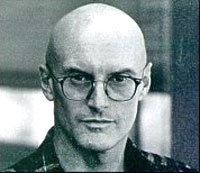
Ken Wilber
|
The Spectrum of Consciousness
Integral Psychology
and the Perennial Philosophy
Biological
and medical scientists are now in the midst of intensive
work on the Human Genome Project, the endeavor to
map all of the genes in the entire sequence of human
DNA. This spectacular project promises to
revolutionize our ideas of human growth, development,
disease, and medical treatment, and its completion will
surely mark one of the great advances in human
knowledge.
Not as well known, but arguably more important, is what
might be called the Human Consciousness Project,
the endeavor, now well under way, to map the entire
spectrum of human consciousness (including, as well,
realms of the human unconscious). This Human
Consciousness Project, involving hundreds of
researchers from around the world, includes a series of
multidisciplinary, multicultural, multimodal approaches
that together promise an exhaustive mapping the entire
range of consciousness, the entire sequence of the
"genes" of awareness, as it were. |
References
-
Gertrude R. Schmeidler, "Respice,
Adspice and Prospice," in W. G. Roll, R. L. Morris & J. D.
Morris (eds.), Proceedings of the Parapsychological Association,
No. 8, 1971. Durham, NC: Parapsychological Association, 1972.
-
John Archibald Wheeler,
Geometrodynamics. New York: Academic Press, 1962.
-
Bob Toben & Fred Alan Wolf,
Space-Time and Beyond. New York: Bantam Books, 1982.
-
Fred Alan Wolf, The Body Quantum.
New York: Macmillan, 1986.
-
Fred Alan Wolf, Star Wave: Mind,
Consciousness, and Quantum Physics. New York: Macmillan, 1984.
-
Fred Alan Wolf, "Trans-World I-ness:
Quantum Physics and the Enlightened Condition," in Humor
Suddenly Returns: Essays on the Spiritual Teaching of Master Da
Free John. Clearlake, CA: Dawnhorse Press, 1984.
-
Fred Alan Wolf, "The Quantum Physics
of Consciousness: Towards a New Psychology," Integrative
Psychiatry, 3(4), December 1985, 236.
-
Fred Alan Wolf, Parallel Universes.
New York: Simon & Schuster, 1988.
-
Russell Targ, Harold E. Puthoff &
Edwin C. May, "Direct Perception of Remote Geographical
Locations," in C. T. Tart, H. E. Puthoff, & R. Targ (eds.), Mind
At Large. New York: Praeger, 1979, pp. 78-106. The authors state
this work was in conjunction with physicist Gerald Feinberg - who is well-known for his postulation of the existence of
tachyons, particles that travel faster than light.
-
Evan Harris Walker ("Review of Mind
At Large," Journal of Parapsychology, 45, 1981, 184-191) has
observed, however, that if we retain the inverse-square law for
gravity, the effect of four extra dimensions on planetary
trajectories should have been observed.
-
Elizabeth A. Rauscher, "Some
Physical Models Potentially Applicable to Remote Perception," in
A. Puharich (ed.), The Iceland Papers. Amherst, WI: Essentia:
1979. pp. 50-93.
-
Elizabeth A. Rauscher, "The Physics
of Psi Phenomena in Space and Time. Part I. Major Principles of
Physics, Psychic Phenomena, and Some Physical Models," Psi
Research, 2(2), 1983, 64-88.
-
Elizabeth A. Rauscher, "The Physics
of Psi Phenomena in Space and Time. Part II. Multidimensional
Geographic Models," Psi Research, 2(3), 1983, 93-120.
-
C. Ramon & Elizabeth A. Rauscher,
"Superluminal Transformations in Complex Minkowski Spaces,"
Foundations of Physics, 10, 1980, 661-669.
-
John S. Bell, "On the Einstein
Podolsky Rosen Paradox," Physics, 1(3), 1964, 195-200.
-
Nick Herbert, "Crytographic approach
to hidden variables," American Journal of Physics, Vol. 43, No.
4, April 1975, pp. 315-316. This paper presents a proof of
Bell’s theorem by considering error rates in binary message
sequences. It also speculates about the possibility of
faster-than-light signaling.
-
Nick Herbert, Faster Than Light. New
York: New American Library, 1988.
-
J. S. Bell, Nature, 248, March 22,
1974, 297.
-
S. D. Drell, "Electron-Positron
Annihilation and the New Particles," Scientific American, June
1975.
-
John F. Clauser & Abner Shimony,
"Bell’s Theorem: Experimental Tests and Implications," Reports
on Progress in Physics, 41, 1978, 1881.
-
Alain Aspect, Jean Dalibard & Gerard
Roger, "Experimental Test of Bell’s Inequalities Using
Time-varying Analyzers," Physical Review Letters, 49, 1982,
1804.
-
E. Wigner, Symmetries and
Reflections. Indiana University, 1967, and Cambridge, Mass.:
M.I.T. Press paperback edition, 1970.
-
Brian Josephson, "Possible
Connections Between Psychic Phenomena and Quantum Mechanics,"
New Horizons, January 1975, 224-226.
-
P.A. Schilpp, Albert Einstein
Philosopher Scientist. New York: Harper Torchbook, 1959. p. 85.
Einstein uses the German word "telepathisch" in the original
version.
-
I. J. Good, "Speculations Concerning
Precognition," in I. J. Good (ed.), The Scientist Speculates.
New York: Basic Books, 1962, pp. 151-157.
-
Nick Herbert, Quantum Reality. New
York: Doubleday, 1985.
-
David Bohm, Wholeness and the
Implicate Order. London: Routledge & Kegan Paul, 1980.
-
Evan Harris Walker, "Foundations of
Paraphysical and Parapsychological Phenomena," in L. Oteri
(ed.), Quantum Physics and Parapsychology. New York:
Parapsychology Foundation, 1975, pp. 1-53.
-
Evan Harris Walker, "A Review of
CritAcisms of the Quantum Mechanical Theory of Psi Phenomena,"
Journal of Parapsychology, 48, 1984, 277-332.
-
Evan Harris Walker, "Measurement in
Quantum Physics Revisited: A Response to Phillips’ Criticism of
the Quantum Mechanical Theory of Psi," Journal of the American
Society for Psychical Research, October 1987, 81(4), 333-369.
-
Richard D. Mattuck, "Random
Fluctuation Theory of Psychokinesis: Thermal Noise Model," in J.
D. Morris, W. G. Roll & R. L. Morris (eds.), Research in
Parapsychology 1976. Metuchen, NJ: Scarecrow Press, 1977, pp.
191-195.
-
Richard D. Mattuck, "A Model of the
Interaction Between Consciousness and Matter using Bohm-Bub
Hidden Variables," in W. G. Roll, R. L. Morris, & R. A. White
(eds.), Research in Parapsychology 1981. Metuchen, NJ: Scarecrow
Press, 1982, pp. 146-147.
-
Saul-Paul Sirag, "A Combinatorial
Derivation of the Proton-Electron Mass Ratio." Nature, 268, July
7, 1977, 254.
-
Saul-Paul Sirag, "Physical Constants
as Cosmological Constraints," International Journal of
Theoretical Physics, 22, 1983, 1067-1089.
-
Saul-Paul Sirag, "Why There Are
Three Fermion Families," Bulletin of the American Physics
Society, 27(1), 1982, 31.
-
G. Abrams, et al., "Initial
Measurements of the Z Boson Resonance, Physical Review Letters,
63(7), August 14, 1989, 724-727.
-
"Experts Focus on the Birth of the
Universe," San Francisco Examiner, October 13, 1989, p. 2.
-
Douglas M. Stokes, "Theoretical
Parapsychology," in Stanley Krippner (ed.), Advances in
Parapsychological Research, Vol. 5. Jefferson, NC: McFarland,
1987.
-
Ken Wilbur, "Introduction," in K.
Wilbur (ed.), Quantum Questions: Mystical Writings of the
World’s Great Physicists. Boston: Shambhala, 1984.
|










